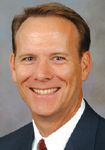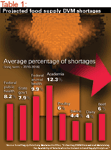Study maps demand directed at food animal DVMs
Minneapolis — A study confirms the shortage of food animal veterinarians in the United States and offers future estimates on the depth of such deficiencies.
MINNEAPOLIS — A study confirms the shortage of food animal veterinarians in the United States and offers future estimates on the depth of such deficiencies.

Dr. Kevin Gwinner
The statistics come with the Food Supply Veterinary Medical Coalition (FSVMC) study "Estimating FSVM Demand and Maintaining the Availability of Veterinarians for Careers in Food Supply Disciplines." According to long-term projections, the United States will see a .6-percent DVM shortage in poultry medicine between 2010 and 2016. Concurrently, an 11-percent shortage will be felt in federal food safety while the beef sector ranks the most deficient at 6 percent (see Table 1).

Table 1: Projected food supply DVM shortages
The study's mission: to reverse the foreseeable decline of practitioners in food supply veterinary medicine (FSVM), which might have "critical implications" on society's health and well-being.
"This is breakthrough information, a brand-new data set that's the most comprehensive to date on food animal veterinarians," says David Andrus, PhD, study author and Kansas State University (KSU) marketing head. "The research we hope will change the path of veterinary medicine for the next 20 years."
Tabulating data
The two-year project developed a series of U.S. and Canadian studies organized around two research plans that included labor market demands as well as career attraction and retention. Ten Internet surveys and seven focus groups provided the project's forecasting data, which was presented to 12 expert panels for review, divided among species, government and academia.
While the supply side numbers are complete, Andrus and his colleagues were still tabulating demand-side data at presstime. Sub-sample analysis shows a shortage especially high on the beef and dairy side, Andrus says. But most food animal veterinarians are very satisfied with their occupation and are not thinking about leaving, he adds.
"They're proud and enthusiastic," Andrus says. "The problem is we need more of them."
Supply counters demand
Study results will be released in stages with an intermediate report slated for this fall, but preliminary numbers illustrate food supply veterinarians live in a "changing professional context."
While the supply side dwindles, five compelling issues are increasing food animal veterinarian demand including zoonotic diseases and bioterrorism concerns. At the same time, factors such as tight government budgets, lack of business skills and rising veterinary costs actually decrease demand, study results show.
That does little to offset the supply/demand imbalance, says study co-author Kevin Gwinner, PhD and associate professor in KSU's marketing department.
"It does factor, but the other components outweigh it," he says. "The shortage of students coming in affects that, resulting in more increase than decrease in need."
Selection factors
Anecdotal reports and Association of American Veterinary Medical Colleges statistics show most graduates enter small animal practice, desiring what they believe will be a more agreeable schedule and higher earning potential.
To counter the trend, the study maps out employment selection factors. The top five issues limiting DVM supply into food animal practice start with less emphasis in veterinary institutions and little student exposure to food supply career options at the college level, the study says.
A lack of role models and food supply practice internships also work to hamper food animal practitioner growth, the study adds (see related charts).

Supply in demand: key demographic influencers
Not surprising, early nurturing works to counter the attraction of companion animal medicine, Gwinner says.
"We talked to students about what influences their career decisions," he says. "Of those students going into food animal careers, 81 percent had been actively involved with food animals growing up. By contrast, only 18 percent of the non-food animal group had been previously exposed."
Potential solutions
Gwinner, Andrus and the study's third co-author, KSU associate professor Bruce Prince, PhD, report increasing exposure rates could help balance the inequity. When asked about their career decisions, student focus group participants identified nine influential themes, the study says. While life experiences rank first, concerns regarding student loan debt, the potential for injury on the job and adequate free time earned high placement on their list of assessments.
What's interesting, the researchers say, is that desire to enter a personally meaningful career also carries a lot of weight.

DVM Newsbreak
That's where mentoring plays a role, Andrus says.
"Those who have had food animal veterinarians mentor them in high school are more likely to go into food animal veterinary medicine, and there are a lot of positives attached to these careers." he says. "I think we can turn things around. Ultimately we see a bright future for food animal veterinarians."